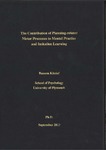The Contribution of Planning-related Motor Processes to Mental Practice and Imitation Learning
| dc.contributor.supervisor | Tucker, Mike | |
| dc.contributor.author | Khalaf, Bassem | |
| dc.contributor.other | School of Psychology | en_US |
| dc.date.accessioned | 2014-04-04T13:46:45Z | |
| dc.date.available | 2014-04-04T13:46:45Z | |
| dc.date.issued | 2014 | |
| dc.identifier | 10226004 | en_US |
| dc.identifier.uri | http://hdl.handle.net/10026.1/2972 | |
| dc.description.abstract |
It is still controversial whether mental practice – the internal rehearsal of movements to improve later performance – relies on processes engaged during physical motor performance and, if so, which processes these are. This series of experiments investigates this question. It utilizes a framework of ideomotor action planning theories, and tests whether mental practice may specifically draw upon planning- rather than execution-related motor processes, specifically those processes that “bind” intended action features to action plans. Experiments 1 to 4 utilize a classical stimulus response compatibility paradigm. Participants mentally practiced complex rhythms with either feet or hands while using the same or different body parts to respond to unrelated sounds. In contrast to previous work on stimulus response compatibility, we indeed found that responses were impaired – rather than facilitated – for those body parts that were concurrently used in mental practice. This result was found when participants mentally trained to memorize the rhythms (Experiment 1), to merely improve their performance (Experiment 3), when mental practice and execution directly followed one another and when separated by a different task (Experiment 4). These data link mental practice not to execution but planning related motor processes that are involved in binding intended action features to intended action plans. Experiment 5 and 6 then extend these results to imitation learning. Participants were instructed to learn the rhythms by observing somebody else, while again making unrelated responses with their hand and feet. While previous work on stimulus response compatibility focussed on testing automatic imitation processes, here imitation was therefore goal directed. We found, as in the previous experiments, that responses with the same body parts as used in the observed rhythms were impaired, suggesting that goal-directed imitation might rely on the same planning-related motor processes as the mental practice of action (Experiment 5). Importantly, these effects were only found as long as participants observed the actions with VI the purpose of imitating them later (i.e. formed action plans), but not when they merely tried to memorize the rhythms for later recognition (Experiment 6). The previous experiments suggest that mental practice and observation learning draw upon body-part specific planning processes. Ideomotor theories suggest, however, that action plans can be relatively abstract, and represented in terms of higher-level goals (i.e. the sequence of left and right button presses independent of the body part used). Experiment 7 and 8 therefore tested whether rhythms learned through mental practice or observation learning could be transferred to other body parts. As expected, we found a relatively high amount of potential transfer when rhythms were mentally practiced with one body part, and then had to be transferred to another body part (Experiment 7). However, this only held when participants learned the rhythms based on an abstract rhythm description, as in Experiments 1 to 4. If participants learned the same rhythms during action observation, any benefits were only obtained when the rhythms later had to be executed with the same (rather than a different) body part. Together, the present data suggest that mental practice does not rely on execution related-motor processes, and points to an involvement of planning related motor processes instead. We argue that such a planning-based account of mental practice is more compatible with the available evidence from body neuroscientific and behavioral studies, and allows one to resolve several debates. Moreover, it allows one to conceptualize goal-directed imitation in a similar manner as mental practice. | en_US |
| dc.language.iso | en | en_US |
| dc.publisher | Plymouth University | en_US |
| dc.subject | Motor Learning | |
| dc.subject | Imitation | |
| dc.subject | Mental Practice | |
| dc.subject | Motor Imagery | |
| dc.subject | Mental Imagery | |
| dc.subject | Action Planning | en_US |
| dc.title | The Contribution of Planning-related Motor Processes to Mental Practice and Imitation Learning | en_US |
| dc.type | Thesis | |
| plymouth.version | Full version | en_US |
| dc.identifier.doi | http://dx.doi.org/10.24382/1617 | |
| dc.identifier.doi | http://dx.doi.org/10.24382/1617 |
Files in this item
This item appears in the following Collection(s)
-
01 Research Theses Main Collection
Research Theses Main


